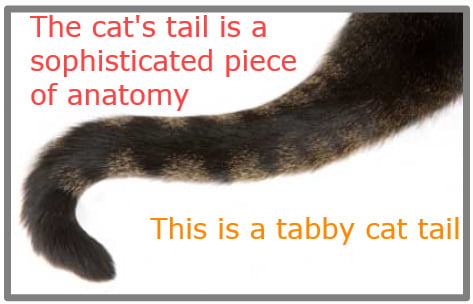
Cat tails are quite complicated anatomically. There are 18 to 20 caudal vertebrae running down the length of the tail. Each vertebra articulates. The vertebrae are held together by ligaments. Muscle is attached to the bone by tendons. The spinal cord runs into a nerve which runs down the length of the tail. There are muscles in the tail which we can see in action when a cat wags her tail or uses it for balance.
Cat tails are covered with fur. The fur grows out of skin surrounding the muscle and the bones of the tail. At the base of the tail there is a gland which secretes an oily substance called sebum. There are caudal glands (scent glands) running down the tail.
I think that I have covered most if not all of the things that make up the anatomy of a cat’s tail. The cat’s tail is very important to a cat from at least two points of view (1) body language and giving signals such as the tail up position reflecting a warm greeting and (2) for balance.
Wide Range
There are wide range of tail types in purebred cats from hairless tails in the Sphynx to beautiful plumed tails in the Maine Coon. There appear to be a preponderance of kinked or tailless cats in Asia which are discussed on this page. Congenital bone defects can cause an absent or kinked tail.
Did you know that the Siamese cat should really have a kinked tail? It was selectively bred out of the cat over many years by cat breeders in America because they thought it was ugly but personally I like it! The snow leopard has the longest tail to body ratio of all cats. It evolved because of the pressure on this cat to maintain balance on steep rocky slopes in the Himalayas.
Paralysis
Sometimes there might be paralysis of the tail which occurs when a car runs over it while the cat is trying to escape from oncoming traffic. Or perhaps the cat owner trapped his cat’s tail in a door as the cat slipped through it. Tail paralysis is a common injury and it may be necessary to amputate it. The reason why the tail becomes paralyzed is because the nerve feeding it is damaged.

